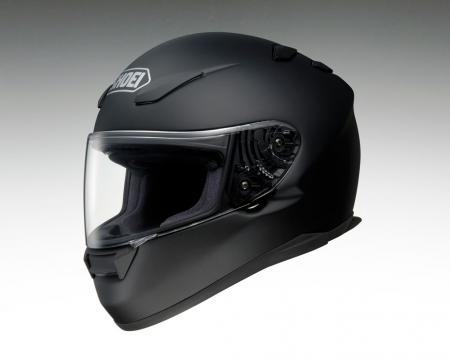2012 Shoei RF-1100 Helmet Review
Shoei's RF-1100 is riding the wave of popularity shared by the RF-1000 before it. For 2012 the RF sees a host of new graphic options.
Despite Shoei’s X12 and VFX-W having such a strong presence in road racing and motocross, respectively, the RF-1100 is the Japanese company’s “best-selling helmet by far,” according to Don Bailey, Shoei’s Technical Advisor for North America.
To examine what makes this helmet so popular, we’re taking another look at the RF-1100 since Pete reviewed it a couple of years ago. In his RF-1100 review, Pete covers all the details of what makes the lid an improvement over the RF-1000, which he also owned and adored.
After speaking with Bret Milan, Shoei’s Marketing Manager, we were surprised to learn the Matte Black version is most in demand, with solid colors outselling graphics. Bailey predicts its largest demographic of buyers are in their mid-to-late 40s.
When pressed to name its competitors, Bailey recognized Shoei’s position as a premium brand but was hesitant to place Shoei above or below anyone else. He did, however, acknowledge that Arai is another on the same level, and Arai’s RX-Q in particular as a rival to the RF-1100.
So which is better? “Shoei doesn’t really get into that,” Bailey says, adding Shoei and Arai have a mutual respect for each other. “What it boils down to is fit. I always stress to potential customers to choose the helmet that fits them best, whatever the brand.”
Milan feels Shoei’s manufacturing processes are what separate it from most of its competitors. “All of our products are 100% handmade in our factories in Japan, which allows us to maintain much higher levels of quality control when compared to competitors that employ outside companies to build their helmets,” he says. “The availability of five different shell sizes to fit virtually every head is another standout feature of a Shoei as well.”
The RF-1100 benefits from a wider eyeport compared to the RF-1000. While this improves the field of vision, unfortunately, it also necessitates the need for a new faceshield. If you have a stack of shields for the RF-1000 hoping to use them on the 1100, you’re out of luck.
Fifteen different faceshields are also available, ranging from clear and dark smoke choices, to high-definition yellow. Or, as it shares the same CW-1 shield with the X12 racing helmet, you can even choose a shield with tear-off posts. Shields with Pinlock posts are also available. Prices range from $95.99 for iridium finishes to $52.99 for a standard CW-1 clear replacement. Changing shields is as easy as it gets thanks to a simple mechanism that never frustrates.
Compared to the Arai RX-Q, I’d personally choose the Shoei if I were to take a cross-country tour. Its shell shape is better suited to my long-oval head size, meaning better comfort over long distances. Arai’s new Signet-Q, designed for long-oval heads and reviewed here, is a better shape for my dome than the RX-Q, but the RF-1100’s shell is still slightly more generous around my head than either offering from Arai. Different head shapes will dictate which lid is right for you, as Bailey mentioned earlier. Otherwise, the RF and Qs are equally matched in virtually every category except price.
The MSRPs of the RF-1100s range from $440.99 (solids) to $551.99 (graphics). Competitors at this level include the AGV Grid ($399.95 - $549.95), HJC RPS-10 ($349.99 - $549.99), and both the Bell Star and RS-1 ($549.95 - $599.95 and $349.95 - $439.95, respectively).
Of course, we can’t leave out Arai, but its offerings are priced higher. Its least expensive full-face helmet, the Vector-2, carries a price tag ranging from $499.95 to $629.95. The aforementioned RX-Q starts at $579.95 for solids, and up to $709.95 for graphic-intensive models; Signet Qs are priced slightly higher. This is a significant jump up in price from the RF-1100.
Personally, what I like best about the RF-1100 is its comfort and ventilation. It fits my long-oval noggin well without any hotspots. And it vents well because “Shoei is one of the only manufacturers to have its own wind tunnel,” Bailey says. “This allows us to examine intake and exhaust ports, and study areas of high or low pressure around the helmet for optimum airflow.”
The only downside I have with the RF-1100 is its physical size and weight. According to Bailey, in order to meet Snell M2010 standards, “the helmets grew physically to meet energy management criteria.” At just over three pounds, it’s not the lightest helmet, either.
“If it were me, I’d figure out a way to shrink these helmets back to pre-Snell M2010 sizes,” says Bailey. These gripes have been noted by Shoei Japan and are surely being taken into consideration for the next generation of helmets.
All told, once the RF-1100 is on my head and I’m moving down the road, I hardly notice it’s there. Its fit, ventilation and aerodynamics offer superb comfort, even for an all-day ride. Combine that with a stunning collection of graphic choices, all individually applied by a real person in Japan, and you start to respect the time and effort spent to create each lid.
The deciding factor for me, however, is the peace of mind knowing, sight unseen, the RF-1100 will fit my head. This is an anxiety I have with other helmets made outside of Japan. If I had to put down my own money for a helmet, it’s for these reasons I wouldn’t hesitate to purchase an RF-1100.
Related Reading
Shoei RF-1100 Review
2011 Shoei Qwest Helmet Review
2011 Arai Signet-Q Helmet Overview
2011 KBC VR4R Helmet Review
2010 Arai Corsair V Helmet Review
More by Troy Siahaan
































Comments
Join the conversation